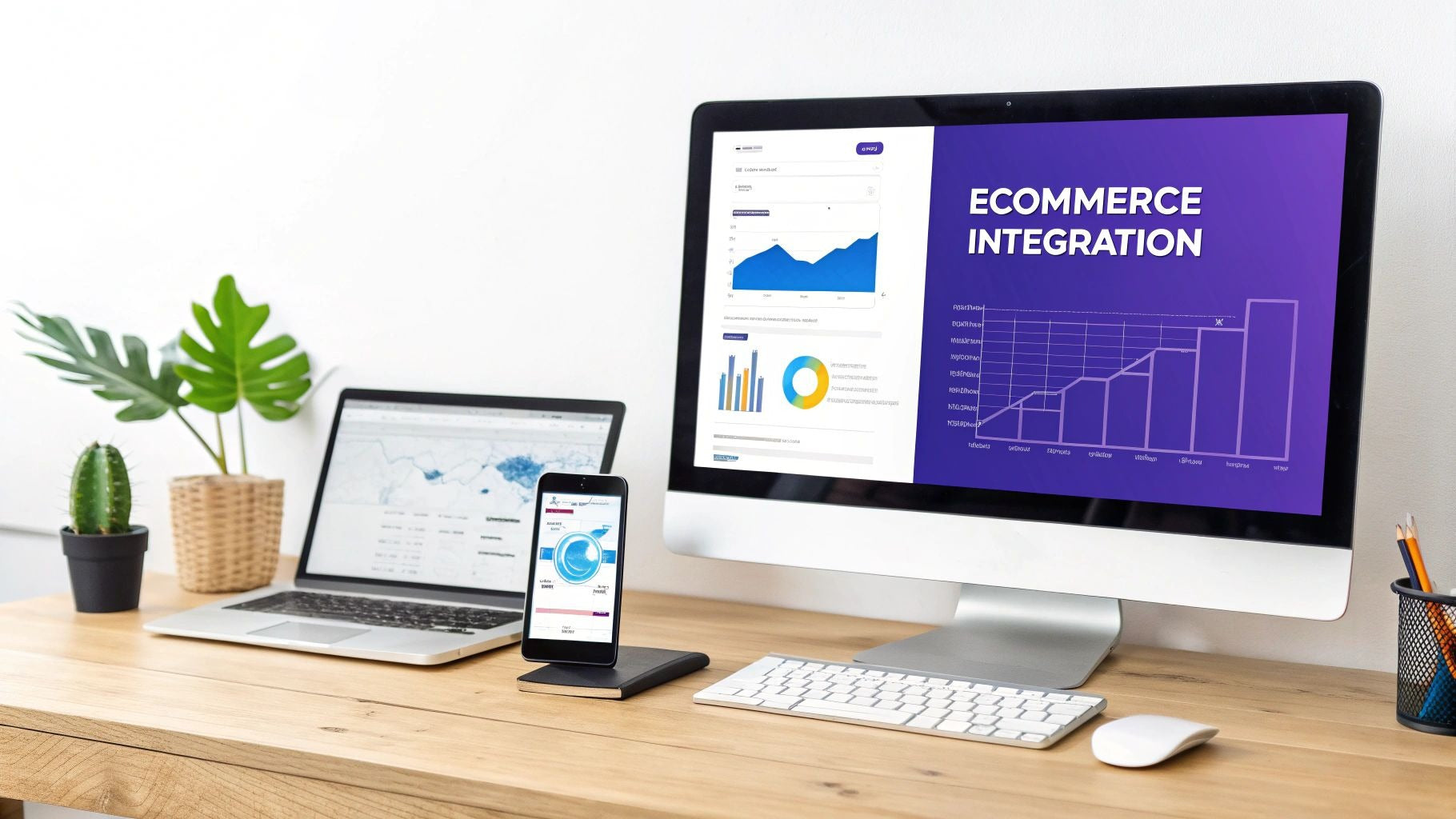The Foundation: Understanding Ecommerce Platform Integration
In the competitive online retail world, ecommerce platform integration is essential. It's the core of any successful online business, linking the various digital tools that manage everything from inventory and sales to customer relationships and marketing. This integration creates a single, unified system where data flows smoothly between different applications.
This eliminates data silos and boosts overall efficiency. For instance, picture a customer ordering from your Shopify store. With the right integration, the order automatically updates inventory, notifies your fulfillment center, and updates sales reports—all without manual work.
This interconnectedness helps businesses scale and thrive.
Why Integration Matters: Moving Beyond Siloed Systems
Businesses often used to operate with separate systems that didn't communicate. This created information silos, duplicated work, inaccuracies, and lost revenue. Now, with cloud-based solutions and APIs (Application Programming Interfaces), businesses can connect these once-isolated systems.
This connectivity enables real-time data sharing, crucial for informed decisions and a seamless customer experience. Businesses can respond quickly to market changes, personalize customer interactions, and optimize operations for maximum efficiency.
The ecommerce platform market is expanding rapidly. Spending is expected to reach $22.6 billion globally in the next 12 months. The US leads with $8.4 billion, representing 37% of the total spend. Platforms like Shopify and WooCommerce drive this growth, with WooCommerce boasting the largest customer base at 430,000 global installations. For a more detailed breakdown of market statistics, you can visit: https://hginsights.com/market-reports/ecommerce-platform-market-share-buyer-landscape
Key Types of Ecommerce Platform Integrations
Several key integrations are the foundation of a solid ecommerce system. Understanding their functions and benefits is vital for a successful integration strategy.
-
ERP Integration: Linking your Enterprise Resource Planning (ERP) system with your ecommerce platform syncs crucial data like product information, orders, and inventory. This removes manual data entry and ensures accuracy.
-
CRM Integration: Integrating your Customer Relationship Management (CRM) system provides a complete view of your customers. This enables personalized marketing, targeted promotions, and better customer service.
-
Marketing Automation Integration: This connects your ecommerce platform with your marketing automation tools. This automation allows you to automate email campaigns, track customer behavior, and personalize the shopping experience.
-
Payment Gateway Integration: Secure and efficient payments are vital for any ecommerce business. Payment gateway integration streamlines transactions and ensures a smooth checkout.
-
Shipping and Fulfillment Integration: Connecting your ecommerce platform with your shipping and fulfillment providers automates order fulfillment, tracking, and delivery updates. This creates a seamless experience.
The table below details the different types of integrations, their functions, impact, and complexity:
To help you better understand the different types of ecommerce platform integrations, we've compiled a comparison table highlighting their core functions, business impact, and implementation complexity.
| Integration Type | Primary Function | Business Impact | Implementation Complexity |
|---|---|---|---|
| ERP Integration | Synchronizes product information, orders, and inventory data | Eliminates manual data entry, improves accuracy, and optimizes inventory management. | Medium to High |
| CRM Integration | Provides a 360-degree view of customer data | Enables personalized marketing, targeted promotions, and improved customer service. | Medium |
| Marketing Automation Integration | Automates marketing campaigns and tracks customer behavior | Improves efficiency, personalizes the customer journey, and increases conversion rates. | Low to Medium |
| Payment Gateway Integration | Processes online payments securely and efficiently | Streamlines transactions, reduces cart abandonment, and enhances customer trust. | Low |
| Shipping and Fulfillment Integration | Automates order fulfillment, tracking, and delivery updates | Improves shipping efficiency, reduces errors, and provides real-time delivery information. | Medium |
As this table shows, each integration type offers distinct advantages, and selecting the right ones depends on your specific business needs and resources. Understanding the complexities and potential benefits can help you prioritize which integrations to implement first for maximum impact. These integrations are crucial for a unified commerce experience. They automate processes, improve data accuracy, and provide a better customer experience. By understanding each integration, businesses can make informed decisions about connecting systems and leveraging their data.
Beyond Theory: Real Benefits of Seamless Integration

Ecommerce platform integration is more than just a technical detail. It's a strategic decision with substantial benefits for your business. When your systems communicate effectively, your entire operation is streamlined, impacting daily tasks and long-term profits. Think about how much time is wasted on manual data entry, a common source of errors. Integrated systems eliminate this, saving money and allowing your team to focus on more important tasks.
Integrating your ecommerce platform also minimizes errors that can negatively impact your customers and your bottom line. Inaccurate inventory, slow order processing, and delayed shipping notifications are all problems that a unified system can solve. This leads to happier customers and increased loyalty. For more insights, check out this article on customer retention: How to master customer retention strategies to boost sales. This improved accuracy and efficiency also contribute to a healthier profit margin.
Real-time inventory visibility is another significant advantage. Integration allows businesses to see exactly what's in stock across all their sales channels. This helps prevent stockouts and ensures prompt order fulfillment. This builds trust with customers and prevents lost sales due to inaccurate inventory information. Ecommerce data integration is key to optimizing these operations. It unifies data sources, provides real-time updates, and automates processes. Learn more about ecommerce data integration here: DataForest.ai. This level of control is essential for any successful omnichannel strategy.
Measurable Improvements: Impact on Key Metrics
Integrating your ecommerce platform directly improves key performance indicators. Strategic implementation leads to better conversion rates, higher average order value, and increased customer lifetime value. A streamlined checkout process, personalized recommendations, and targeted marketing campaigns create a smoother, more enjoyable customer journey. This, in turn, drives sales and strengthens customer relationships. These aren't just theoretical advantages; they have a real impact on your profitability.
Calculating ROI: Justifying Integration Investments
The benefits of integration are clear, but you also need a way to measure your return on investment (ROI). This justifies the cost of implementation and demonstrates the long-term value of an integrated system. By analyzing factors like reduced labor costs, fewer errors, and increased sales, businesses can quantify the financial benefits of ecommerce platform integration. This data-driven approach supports the decision to integrate and provides a clear path to achieving your desired results. This strategic approach ensures that the investment aligns with business goals and delivers measurable value.
Platform Showdown: Integration Capabilities That Matter

Picking the right ecommerce platform is a big deal, especially when it comes to integrating all the moving parts of your online business. This isn't a one-size-fits-all situation; different platforms have different strengths. This section dives into the integration capabilities of popular platforms like Shopify, WooCommerce, Magento, and BigCommerce. Understanding these differences can save you headaches down the road.
Native Integrations: Built-In Connectivity
Every platform comes with its own set of native integrations – pre-built connections to other software. Shopify, for instance, boasts a massive app store packed with thousands of integrations. This makes linking up with essential tools like email marketing platforms and CRM systems a breeze.
WooCommerce, being open-source, leans heavily on plugins for integrations. This offers incredible flexibility but also means you need to carefully check the quality and security of each plugin.
Magento, known for its enterprise-grade features, also offers a robust set of native integrations. However, its complexity can be a bit much for smaller businesses to handle.
BigCommerce aims for a sweet spot between pre-built integrations and customization. It offers a good selection of native integrations alongside an open API for more specialized needs. Ultimately, the best choice depends on your specific needs and technical skills.
API Robustness: The Foundation for Custom Integrations
Native integrations are great, but a strong API is essential for custom solutions. A well-documented and flexible API lets developers connect your platform to almost any other system. Shopify's API is known for being developer-friendly, which is why it's a favorite for businesses that need custom integrations.
WooCommerce, thanks to its WordPress base, also has extensive API access. Customizing it, however, might require more technical know-how. Magento’s API is powerful, but complex, demanding specialized knowledge to unlock its full potential. BigCommerce offers a robust API that balances ease of use with customization, a key factor for growing businesses needing complex integrations.
Shopify holds approximately 28.6% of the market share among the top one million sites, while WooCommerce holds 44% in regions like India. Choosing a platform with substantial market share means access to a larger community and more readily available resources. You can find more details on market share here: Ecommerce Platform Market Share.
Third-Party Apps and Connectors: Expanding Possibilities
Third-party apps and connectors can greatly expand a platform's integration capabilities. Shopify's app store is a vast marketplace of extensions, providing solutions for nearly every integration need. WooCommerce benefits from the huge WordPress plugin ecosystem, offering a wide array of integration options, though careful selection is key.
Magento's marketplace also has many extensions, but the cost and complexity can be substantial. BigCommerce offers a curated app marketplace with a solid selection of integrations, prioritizing quality and reliability. These third-party options offer solutions tailored to specific business needs.
To help you compare, here’s a quick overview:
Ecommerce Platform Integration Comparison: Detailed comparison of major ecommerce platforms' integration capabilities
| Platform | Native Integrations | API Quality | Third-Party App Ecosystem | Custom Integration Support |
|---|---|---|---|---|
| Shopify | Extensive | Excellent | Vast and well-curated | Strong developer community |
| WooCommerce | Moderate | Good | Large but requires vetting | Requires WordPress expertise |
| Magento | Robust but complex | Powerful but complex | Large but can be expensive | Requires specialized Magento developers |
| BigCommerce | Solid selection | Good balance of ease and power | Curated and reliable | Good developer support |
This table summarizes the key integration aspects of each platform. The "best" platform truly depends on your business requirements, technical resources, and future goals. Carefully consider your unique integration needs before making a decision.
Right-Sized Integration: Strategies For Your Business Scale

When it comes to ecommerce platform integration, finding the perfect fit is key. There's no single solution that works for everyone. The best approach depends on your business's size and unique needs. A small startup will have different requirements than a large enterprise. This section explores integration strategies tailored for businesses at different growth stages, helping you choose the most effective path.
Starting Small: Essential Integrations for Early Growth
For smaller businesses, the initial focus should be on the essentials. Building a solid foundation with core connections is paramount, without overspending. This typically involves integrating essential systems like payment gateways and shipping providers to streamline operations.
Think of it like building a house. You start with the foundation and framing before adding the finishing touches. A cost-effective early strategy might involve using pre-built integrations and plugins.
This approach provides essential connectivity without requiring extensive custom development, saving valuable resources. By focusing on these core connections, businesses can establish efficient workflows and prepare for future expansion.
Scaling Up: Strategic Integrations for Mid-Sized Businesses
As your business grows, so do your integration needs. Mid-sized businesses need to find a balance between current demands and long-term planning. This stage requires a more strategic approach to scaling the integration infrastructure.
Integrating with a CRM becomes crucial for managing increasing customer data and personalizing interactions. It's like adding rooms to your house as your family grows — you need to plan for the future while addressing present needs.
This involves evaluating various integration options, considering factors like scalability, flexibility, and cost. Prioritizing integrations based on their potential business impact and implementation complexity is key to maximizing ROI. This ensures that integrations support current operations while also enabling future growth.
Enterprise Level: Omnichannel Integration for Complex Operations
Enterprise organizations require sophisticated omnichannel solutions to unify complex global operations. These businesses often manage multiple sales channels, vast amounts of data, and intricate logistics. Their ecommerce platform integration strategy must be both robust and adaptable.
At this level, integration becomes the central nervous system of the business, connecting everything from global supply chains to personalized customer experiences. Think of a sophisticated smart home where all systems communicate seamlessly.
This usually involves a combination of native integrations, API-led connections, and custom-built solutions. Robust data synchronization, real-time visibility across all channels, and advanced analytics are critical. This comprehensive approach helps enterprises manage complex operations and deliver seamless customer experiences.
Prioritizing Your Integration Roadmap: A Decision Framework
No matter your business size, a prioritized integration roadmap is essential. Use a decision framework based on business impact, implementation complexity, and available resources.
Ask yourself: Which integrations will offer the greatest return? Which are easiest to implement? Which align with our current budget and technical capabilities? By answering these questions, you can create a phased approach, starting with high-impact, low-complexity projects.
This allows for quick wins and demonstrates the value of ecommerce platform integration before tackling more complex initiatives. A well-defined roadmap ensures a scalable and sustainable integration ecosystem that supports your overall business goals.
Breaking Down Technical Approaches Without the Jargon
Let's explore the technical side of ecommerce platform integration. This section explains different integration architectures, from basic connections to more complex methods, in plain English. Understanding these approaches will equip you to communicate effectively with developers and make informed decisions about your integration strategy.
From Point-to-Point to API-Led: Understanding Architectures
Point-to-point integration is like drawing a line between two apps. It's straightforward for basic connections, but becomes complicated as you add more systems. Managing multiple point-to-point connections can quickly become a tangled mess.
API-led integration, on the other hand, creates a central hub. All your apps connect to this central point, making adding or removing connections significantly easier. This simplifies management and offers more flexibility for future growth.
Middleware vs. iPaaS: Choosing the Right Tool
Traditional middleware acts like a translator between different software systems. While effective, it can be complex and expensive to set up and maintain.
iPaaS (Integration Platform as a Service) offers a modern, cloud-based alternative. These platforms provide a pre-built integration hub that's ready to go, often with user-friendly interfaces and less technical overhead. iPaaS solutions are a more accessible option for many businesses.
You might be interested in: How to master ecommerce subscription management.
Webhooks and Event-Based Architectures: Enabling Real-Time Experiences
Webhooks deliver real-time notifications. When an event occurs in one app, a webhook instantly sends a message to another. For instance, when a customer places an order, a webhook can trigger an automatic inventory update. This real-time communication is crucial for providing a seamless customer experience.
This leads to event-based architectures, where systems react to specific triggers. One event triggers another, creating a chain of automated actions. This allows businesses to react quickly, personalize customer interactions, and optimize operations.
Making Informed Decisions: Practical Examples
Integrating your ecommerce platform with your CRM might call for a point-to-point solution if you have limited integrations. But if you plan to connect multiple systems, an API-led approach or iPaaS solution would offer greater scalability and flexibility.
If you need real-time inventory updates, webhooks are key. Understanding these technical approaches helps you have productive conversations with developers and select the best solution for your business needs. This empowers you to make strategic decisions, even without a deep technical background. By understanding these different integration methods, you can ensure smooth data flow and increased efficiency.
Overcoming Integration Roadblocks: Practical Solutions
Integrating your ecommerce platform can be a complex undertaking, and even the most meticulously planned projects can hit unexpected snags. This section explores common challenges businesses encounter during ecommerce platform integration and offers practical solutions to navigate these hurdles.
Data Quality Issues: Cleaning Up the Mess
Data inconsistencies between different systems present a major obstacle. Imagine merging customer databases with varying naming conventions or missing information. This can lead to inaccurate reporting, ineffective marketing campaigns, and frustrated customers. The solution? Implement a robust data cleansing process before initiating the integration. This involves standardizing data formats, identifying and correcting errors, and removing duplicate entries. Think of it as spring cleaning for your data – essential preparation for a smooth integration.
System Compatibility Problems: Bridging the Gap
Integrating systems built with different technologies can be challenging. System compatibility problems can lead to project delays, errors, and escalating costs. One effective solution is utilizing middleware or an iPaaS (Integration Platform as a Service) solution. These platforms act as intermediaries between different systems, enabling seamless communication. Alternatively, building custom connectors, while potentially more resource-intensive, offers greater control and flexibility for intricate integrations.
Legacy System Integration: Taming the Beast
Integrating older legacy systems poses unique challenges. These systems often have poor documentation, rely on outdated technologies, and might lack APIs. Connecting them to modern ecommerce platforms can feel daunting. A practical approach is to phase out the legacy system incrementally, integrating specific functions one by one. Another solution involves using specialized integration tools designed for compatibility with older systems. You might find this resource helpful: How to master improving your customer onboarding process. This measured approach ensures a smoother transition and minimizes disruption.
Security and Compliance: Staying Safe
Security is paramount during ecommerce platform integrations. Exposing sensitive data during the process increases vulnerability to breaches. Maintaining compliance with regulations like GDPR and PCI DSS is also crucial. The solution? Implement robust security measures throughout the entire integration process. This includes utilizing secure APIs, encrypting data both in transit and at rest, and performing regular security audits. These practices safeguard your business and foster customer trust.
Data Synchronization: Keeping Everything in Sync
Managing data synchronization between systems with different data models can be complex. Consider the challenge of maintaining consistent inventory levels across multiple sales channels with varying update frequencies. Establishing clear data ownership and update protocols is essential. Define a single "source of truth" for each data point and implement a consistent update schedule. This maintains data accuracy and prevents conflicts. A centralized data management platform that automates data synchronization across all systems is another valuable solution.
Handling Peak Loads: Scaling for Success
During peak periods such as Black Friday or holiday sales, your integration must handle increased traffic without failure. Integration failures at these critical times can lead to lost sales and damage your brand reputation. The solution lies in thorough load testing before peak periods. Simulate high traffic volumes to identify potential bottlenecks. This proactive approach prevents disruptions and ensures a positive customer experience. Leveraging cloud-based integration platforms that automatically scale to accommodate increased demand provides another effective solution.
Future-Proofing Your Integration Strategy
The world of ecommerce platform integration is constantly evolving. Is your current strategy flexible enough to adapt to future changes? This section explores emerging technologies that are reshaping how systems connect and communicate, ensuring your integrations remain valuable as ecommerce continues to develop.
The Rise of Predictive Integrations: AI and Machine Learning
Artificial intelligence (AI) and machine learning are changing integrations from reactive to predictive. These technologies analyze historical data to anticipate potential problems before they impact customers. Imagine an integration that predicts inventory shortages based on sales data and automatically adjusts purchase orders. This proactive approach minimizes disruptions and improves customer satisfaction. This shift toward predictive capabilities is essential for businesses looking to optimize operations and stay competitive.
Headless Commerce: Redefining Integration Approaches
Headless commerce is changing the way we think about integrations. By separating the front-end presentation from the back-end ecommerce functionality, businesses gain significant flexibility. This means you can use any front-end technology, from a mobile app to a voice assistant, to deliver a personalized customer experience. This architectural change simplifies integration with new customer touchpoints and allows for faster development. This adaptability is crucial in today's market where customer expectations are always changing.
The Expanding Ecosystem: Voice Commerce and IoT
Voice commerce and the Internet of Things (IoT) are introducing new integration needs. As consumers increasingly use voice assistants and connected devices to shop, businesses need to integrate their ecommerce platforms with these new channels. This requires new approaches to data management, security, and user experience. For example, integrating with a smart refrigerator could allow for automatic grocery ordering, creating a seamless and convenient shopping experience. Businesses that plan for the future are already exploring these opportunities to stay ahead of the curve.
Building an Adaptable Integration Strategy: Key Considerations
Building a future-proof integration strategy requires thoughtful planning. Here are some key factors to consider:
- Flexibility: Choose platforms and tools that easily integrate with new technologies.
- Scalability: Ensure your integration infrastructure can handle increasing data and transactions.
- Security: Prioritize security measures to protect sensitive information as your ecosystem grows.
- Innovation: Explore new technologies and experiment with new integration methods.
By focusing on these principles, you can build an integration strategy that adapts to the constantly changing ecommerce landscape. This proactive approach will help your business remain competitive and deliver excellent customer experiences.
Ready to transform your Shopify store into a thriving hub for courses and community engagement? Tevello offers a seamless integration that brings together digital products, educational content, and interactive learning experiences, all within your existing Shopify environment. Explore the possibilities and take your business to the next level.




